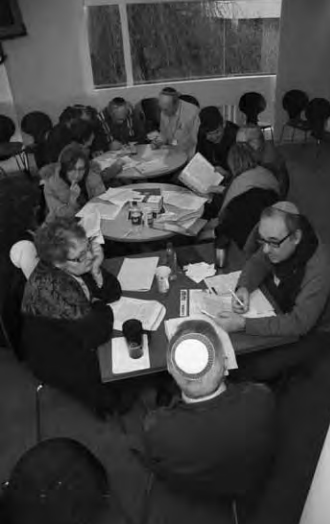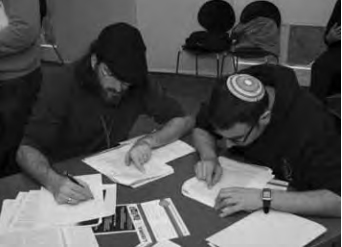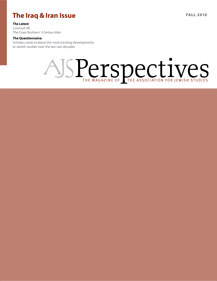
Answer: A Limmud conference, of course.

For the uninitiated, Limmud began in 1980 after a group of British-Jewish educators attended a conference of the Coalition for the Advancement of Jewish Education (CAJE), a New York-based, nonprofit organization that closed its doors about two years ago during the global financial collapse. After attending CAJE, the British participants decided to create a similar conference model, though slightly tweaked. Limmud, from its inception, has always been volunteer-driven and open to anyone interested in Jewish learning. The first Limmud UK conference took place a year later as a one-day conference with about eighty-five participants. The conference was such a success that it soon expanded, and over the years has grown into the flagship residential retreat, a summer festival that emphasizes learning and music, plus day-long regional Limmud programs over the course of the year. This year's Limmud UK offered more than nine hundred sessions, and the 380-page program weighed over one pound.
Although I had been to two Limmud Colorado conferences prior to Limmud UK, I didn't realize just how radical and exciting it could be to attend a conference where the diversity of Jews (politically, religiously, culturally, demographically) is simply astonishing. Two cases in point: I first arrived at midnight, bleary eyed after a long flight from San Francisco and a two-and-a-half-hour bus ride. As I stumbled into the main building, I ran into an acquaintance who volunteers with Limmud LA. Two minutes later, I was greeted by a long-lost friend from Chicago, who now lives in Scotland, and is a diehard volunteer for Limmud UK. Ten minutes later, in the loud, packed, and buzzing bar upstairs, I saw no less than three colleagues from Israel and several friends from New York. At dinner the next night, I sat next to a lovely older German man, who I later discovered is a leading historian of medical ethics, particularly during the period of National Socialism. Seated on my other side was a feisty, Israeli-British, thirty-something "professional Jew," who identifies as "polymorphously post-denominational," and moonlights as a drag king in wickedly funny and subversive cabaret shows. Across the table: the director of the Conservative Yeshiva in Jerusalem. The four of us couldn't stop talking and laughing, despite the range in our ages, identities, backgrounds, and practices.
The above anecdotes reveal a tiny glimpse of how Limmud harnesses the power of both global and local networks of Jews and involves the widespread circulation of Jewish people, ideas, texts, histories, financial resources, and culture. To date, the Limmud model has expanded to forty-four different cities throughout the world, including South Africa, Argentina, Israel, Sweden, Ukraine, and several U.S. and Canadian cities (see www.limmudin ternational.org for the complete listing). The typical roster of presenters reflects the volunteer teams' connections to the global Jewish community of educators, intellectuals, musicians, activists, artists, and ordinary teachers/ learners in Jewish communities. In fact, many people who fit into several of those categories travel the "Limmud circuit" around the world. One person I know has been to Limmud NY, Colorado, UK, Sweden, and will soon attend Limmud South Africa. At the same time, Limmud is always local, reflecting regional sensibilities and concerns. At this Limmud, for example, I noticed that there was an unusually large number of sessions devoted to widely diverse perspectives, ideas, and feelings about Zionism, Israel, and notions of Jewish peoplehood and identity, perhaps reflecting England's closer proximity to Israel and the anxieties of British Jews about anti-Semitism.
Limmud is a manifestation of the emerging "Jewish innovation ecosystem," a postmodern, decentralized, and democratic form of Jewish identity, expression, and community building championed by the organization Jumpstart, "a thinkubator for sustainable Jewish innovation." Limmud could also be viewed as a Jewish test case for the repudiation of Robert Putnam's thesis in Bowling Alone: The Collapse and Revival of American Community (2001), in which he describes and analyzes the collective costs of decreased civic engagement, the decline of social capital, and the shrinking of participation in the public sphere. Despite Jewish demographic surveys that fret about rates of intermarriage and the perception of a decline in engagement in Jewish communal life, the success of Limmud and the thousands of people who participate globally each year offer a qualitatively different lens to look at questions of how people "do Jewish." In fact, Limmud is a fascinating case study of how many Jews are building temporary, intentional Jewish communities that rely largely on the enlistment, exchange, and accumulation of social capital, globally and locally. Limmud requires and involves face-to-face interaction and is profoundly relationshipintensive and network-driven. Limmud participants are also motivated by desire, rather than a sense of duty or obligation.
The philosophy and ideology of Limmud revolves around notions of democracy, Jewish pluralism, personal choice, and diversity of identity and expression: about what to learn, how to learn, with whom, when, and where. I observed that hierarchy and formality regarding teaching and learning were eschewed. The sessions I attended were marked by casual informality, spirited debates, and discussions, as well as a willingness to dive into complex and difficult texts. A democratic philosophy of participation and engagement infuses most Limmud publications, websites, program booklets, and mission statements:
Limmud aims to enable each participant to go one step further on their own Jewish journey. Everyone is a student and everyone can be a teacher. Events feature all educational styles including lectures, workshops, text-study sessions, film, meditation, discussions, exhibits and performances to ensure that there is always "something for everyone." Indeed, the content of a typical Limmud event is as diverse as its participants.
This philosophy of democratic and nonhierarchical learning offers both an opportunity and a challenge for Jewish studies academics. Indeed, one democratizing aspect of a Limmud conference is the conspicuous absence of titles, credentials, and academic institutions on participant nametags, which only identify the person and the city in which they reside. The fact that anyone can present at Limmud profoundly democratizes the notion of who is allowed to teach and learn. Anyone with an idea can propose a session, and indeed, the line-up ranged from the scholarly, esoteric, and intellectually demanding to workshops that bordered on the risqué, goofy, and creative. Presenters included renowned scholars, psychotherapists, lawyers, doctors, nonprofit professionals, rabbis, poets, philanthropists, and more.
Some scholars might view this as threatening the elite status of academic knowledge production and Jewish studies as an academic vocation. Personally, I found it thrilling. Limmud is potentially liberating for academics who like to move through multiple social and intellectual worlds. Limmud offers a wonderful venue for scholars who work as public intellectuals, who seek a platform for their ideas in the wider world beyond academia, and who want to influence a greater number of people beyond our small, scholarly community. For example, I was able to present my scholarly work, participate in a book talk about queer perspectives on the Torah, perform in a Jewish ritual theater piece, and sit on a skillfully moderated panel about the place of Israel in international Jewish life. Where else can you do so many things in such a short span of time? Finally, Limmud is a great opportunity to have substantive, thoughtful, and enriching conversations with people from all walks of life, who are hungry to learn and are open to different ideas. If I haven't convinced you yet, let me be blunt: you should go.

